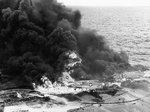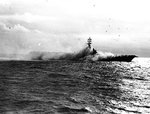GrauGeist
Generalfeldmarschall zur Luftschiff Abteilung
And so I'll go out on a limb here and suppose that the U.S. allowed the leeward islands to be taken with little opposition all the way up to Hawaii.
Now the Japanese have Hawaii. Brilliant move by the Japanese. They have over exteneded their resources even further, having to provide men, material and maritime assets to hold these islands. Now what?
The bulk of U.S. Naval power at this point in time was nearing completion in Naval Shipyards on the East and West coast. The American war machine was no where near it's peak output and as it turned out, never committed it's full measure by war's end.
In order to stop the U.S., they would have to actually invade and hold stratetigic U.S. proper. Taking several dusty little Atolls and the Hawaiian island chain would not come close to forcing the U.S. to the negotiating table. It would actually backfire on the Japanese because now their assets have been stretched thinner than they Historically were prior to the Midway campaign.
Taking Hawaii would no more force the U.S. to the bargaining table than taking Iwo jima forced the Japanese to the bargaining table.
All of this falls deep into the realm of "what if" that has no bearing on the significance of the battle of Midway's outcome.
Now the Japanese have Hawaii. Brilliant move by the Japanese. They have over exteneded their resources even further, having to provide men, material and maritime assets to hold these islands. Now what?
The bulk of U.S. Naval power at this point in time was nearing completion in Naval Shipyards on the East and West coast. The American war machine was no where near it's peak output and as it turned out, never committed it's full measure by war's end.
In order to stop the U.S., they would have to actually invade and hold stratetigic U.S. proper. Taking several dusty little Atolls and the Hawaiian island chain would not come close to forcing the U.S. to the negotiating table. It would actually backfire on the Japanese because now their assets have been stretched thinner than they Historically were prior to the Midway campaign.
Taking Hawaii would no more force the U.S. to the bargaining table than taking Iwo jima forced the Japanese to the bargaining table.
All of this falls deep into the realm of "what if" that has no bearing on the significance of the battle of Midway's outcome.




